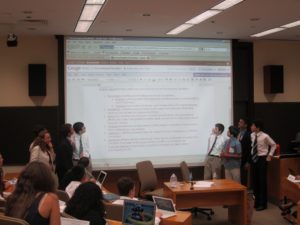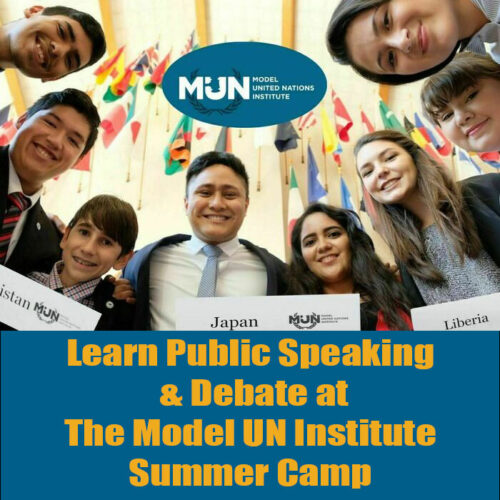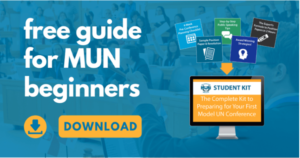
Delegates present their resolutions
Step 1: Determining the “genre” of your topic
The first step to building the perfect solution is to know what type of topic you are dealing with. Not only does this narrow down your research, but it can also help you understand the capabilities of your committee. The “genre” of your topic can range anywhere from security, to humanitarian, to economic. Usually, you’ll be able to determine this simply by looking at the basic information about your committee and topic in the background guide, if provided by your committee chairs, or simply by visiting your committee’s website to learn more about what type of situations it aims to solve.
Once you’ve determined the “genre” of your topic, you will be better equipped to brainstorm and research solutions. This is because different types of topics require completely different solutions. For example, a security-based solution, or one dealing with conflict zones, will often involve solutions centered around peacekeepers and elections. Other more humanitarian based solutions will often require program-based initiatives, working with NGO’s, and room for more creativity. When brainstorming solutions it’s also important to note the mandate of your committee and its capabilities. Keep in mind that each committee has the resources and is permitted to do certain actions. The security council, for instance, usually limits its actions to deploying peacekeepers, imposing sanctions, and condemning governments. If you were not able to define one genre for your topic, you can use subtopics to address each specific genre.
Step 2: Breaking your issue down into subtopics
Subtopics are not only a useful tool when it comes to writing your position paper, but can also help diminish the daunting nature of solution building. By identifying two to four (usually three) areas within your topic that you would like to discuss, you can better organize your solutions to address all three subtopics. If you were not able to define a specific genre for your topic, you can use subtopics to break your issue into three genres, such as economic, humanitarian, and security.
An example of subtopics for a committee on the Situation in Lebanon can be the refugee crisis, border disputes, and terrorism. These subtopics are pretty specific and allow you to delve deeper into your research. This also helps with solution building, because you can focus on creating solutions for these three specific subtopics, instead of being faced with the task of brainstorming solutions for “Situation in Lebanon” as a whole, which at first glance seems intimidating.
Step 3: Analyzing pre-existing solutions
The third step in the process of solution building exists to both inspire your original solutions and improve on pre-existing ones. By analyzing current or past actions taken by the UN, governments, or NGO’s, you can determine what’s been effective and which solutions need improvement. This is a great place to start if you are a beginner delegate and have no experience in solution building. If you are an advanced delegate, this strategy can be used to gain a deeper understanding of the topic and lay the foundation for your original ideas.
To analyze pre-existing solutions you can visit the UN’s website and read through previous resolutions on your topic. You can also research specific plans or programs and determine whether or whether not they’ve been successful in helping solve the issue. For example, if your topic involves the use of peacekeepers there is a lot of controversy regarding their effectiveness. Different online sources can give you information on the progress of peacekeeping missions including the peacekeeping website itself: https://peacekeeping.un.org/en.
Step 4: Brainstorming original ideas
In my opinion, this step is most fun of them all because it involves originality. One of the most rewarding feelings I’ve experienced while on the MUN circuit has been seeing my own ideas manifested in committee resolutions. In order to brainstorm your own ideas you will have had to have conducted in-depth research on your topic and past actions. As you research more and more, you’ll notice how the ideas begin to flood your brain! Original ideas can come in the form of the development or implementation of new technologies, educational curriculums, forums, and anything else that your MUN-loving heart desires! Just make sure that your solutions seriously address all aspects of the topic and are reasonable within the framework of your committee.
Step 5: Funding
During committee sessions, you’ll begin to notice how many delegates stumble when asked how they’re going to fund their solution. This is due to the fact that many delegates forget that funding is an important part of brainstorming their ideas for solutions. It’s important to come into committee prepared to defend your solutions against all possible challenges. To fund your solutions, there are a few places you should look towards such as the budget of your committee, The World Bank, NGO’s, and specific members states. For example, if an NGO is involved in something similar to your proposed solution, you can suggest creating a funding partnership with that NGO. Also, keep in mind that funding methods will vary based on your country policy. The United States, for instance, has more money to put towards programs than a developing country like Tuvalu. Overall, however, don’t worry too much about funding – you can always say “delegates funding decisions to the Fifth Committee of the General Assembly.” This committee oversees administrative and budgetary matters, and is accurate to how the real UN addresses funding!
Step 6: Presenting your solutions (“PAINT”)
The last step will finally take you away from your desk and into your committee room, where you will have the opportunity to present your solution before fellow member states. When I’m presenting my solutions in committee, I like to think of myself as a saleswoman trying to get as many countries as I can to buy my product. In order to be a successful salesperson, you’ll need an effective sales technique to grab the attention of consumers and force them to remember your product. That’s where PAINT comes in. “PAINT” stands for:
P– Phrase (“Lead with Purpose” US National Security Strategy 2015)
A- Acronym (SDG’s: Sustainable Development Goals o Triple R: Refugee Reintegration and Rehabilitation)
I- Image (The “Roadmap” to peace in the Middle East)
N- Number or Name (The UN’s “Zero Hunger Challenge” or “Malala Day”)
T- Time or Year (France’s 2020 Vision, or Russia’s 3-Year Plan)
By utilizing PAINT strategies, both delegates and chairs will remember your ideas. It’s more likely that delegates will mention your solution in their speeches if there’s a catchy acronym or slogan to accompany it. Once you’ve “sold” your solutions to fellow member states, the hard part is over. Now you get to frame your resolution in your room as a lasting reminder of your hard work and creativity!


